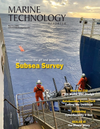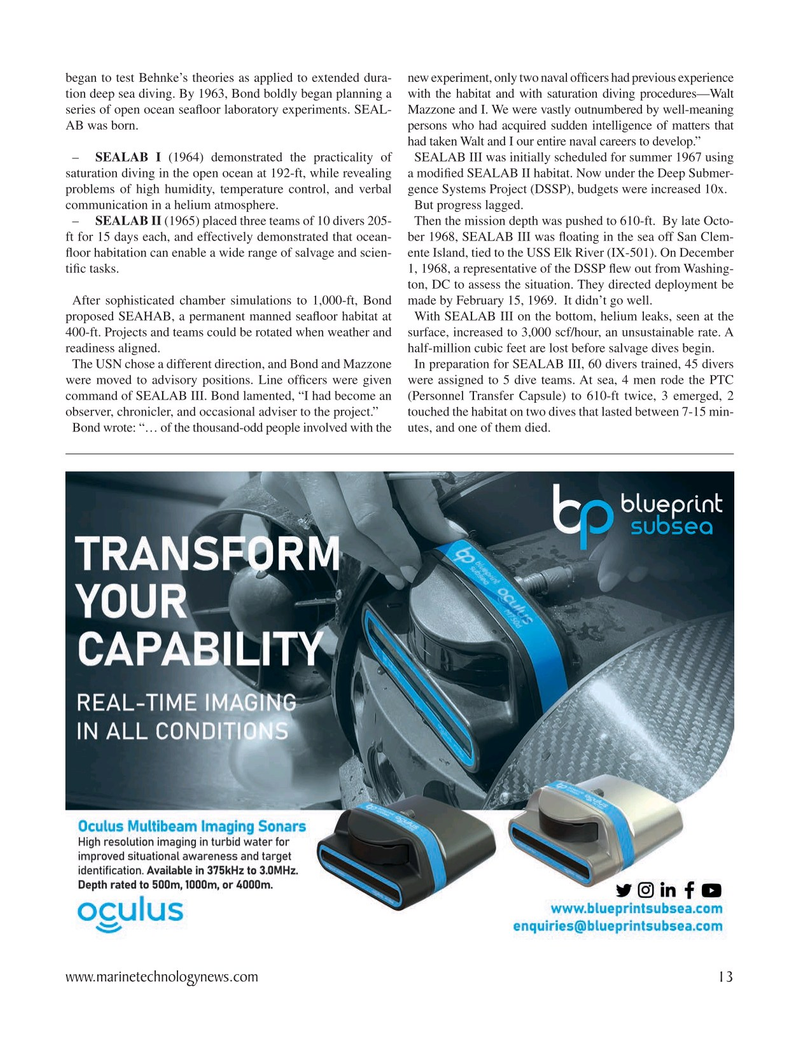
Page 13: of Marine Technology Magazine (May 2024)
Read this page in Pdf, Flash or Html5 edition of May 2024 Marine Technology Magazine
began to test Behnke’s theories as applied to extended dura- new experiment, only two naval of? cers had previous experience tion deep sea diving. By 1963, Bond boldly began planning a with the habitat and with saturation diving procedures—Walt series of open ocean sea? oor laboratory experiments. SEAL- Mazzone and I. We were vastly outnumbered by well-meaning
AB was born. persons who had acquired sudden intelligence of matters that had taken Walt and I our entire naval careers to develop.” – SEALAB I (1964) demonstrated the practicality of SEALAB III was initially scheduled for summer 1967 using saturation diving in the open ocean at 192-ft, while revealing a modi? ed SEALAB II habitat. Now under the Deep Submer- problems of high humidity, temperature control, and verbal gence Systems Project (DSSP), budgets were increased 10x.
communication in a helium atmosphere. But progress lagged. – SEALAB II (1965) placed three teams of 10 divers 205- Then the mission depth was pushed to 610-ft. By late Octo- ft for 15 days each, and effectively demonstrated that ocean- ber 1968, SEALAB III was ? oating in the sea off San Clem- ? oor habitation can enable a wide range of salvage and scien- ente Island, tied to the USS Elk River (IX-501). On December ti? c tasks. 1, 1968, a representative of the DSSP ? ew out from Washing- ton, DC to assess the situation. They directed deployment be
After sophisticated chamber simulations to 1,000-ft, Bond made by February 15, 1969. It didn’t go well.
proposed SEAHAB, a permanent manned sea? oor habitat at With SEALAB III on the bottom, helium leaks, seen at the 400-ft. Projects and teams could be rotated when weather and surface, increased to 3,000 scf/hour, an unsustainable rate. A readiness aligned. half-million cubic feet are lost before salvage dives begin.
The USN chose a different direction, and Bond and Mazzone In preparation for SEALAB III, 60 divers trained, 45 divers were moved to advisory positions. Line of? cers were given were assigned to 5 dive teams. At sea, 4 men rode the PTC command of SEALAB III. Bond lamented, “I had become an (Personnel Transfer Capsule) to 610-ft twice, 3 emerged, 2 observer, chronicler, and occasional adviser to the project.” touched the habitat on two dives that lasted between 7-15 min-
Bond wrote: “… of the thousand-odd people involved with the utes, and one of them died.
www.marinetechnologynews.com 13
MTR #4 (1-17).indd 13 6/2/2024 11:23:23 AM

 12
12

 14
14
